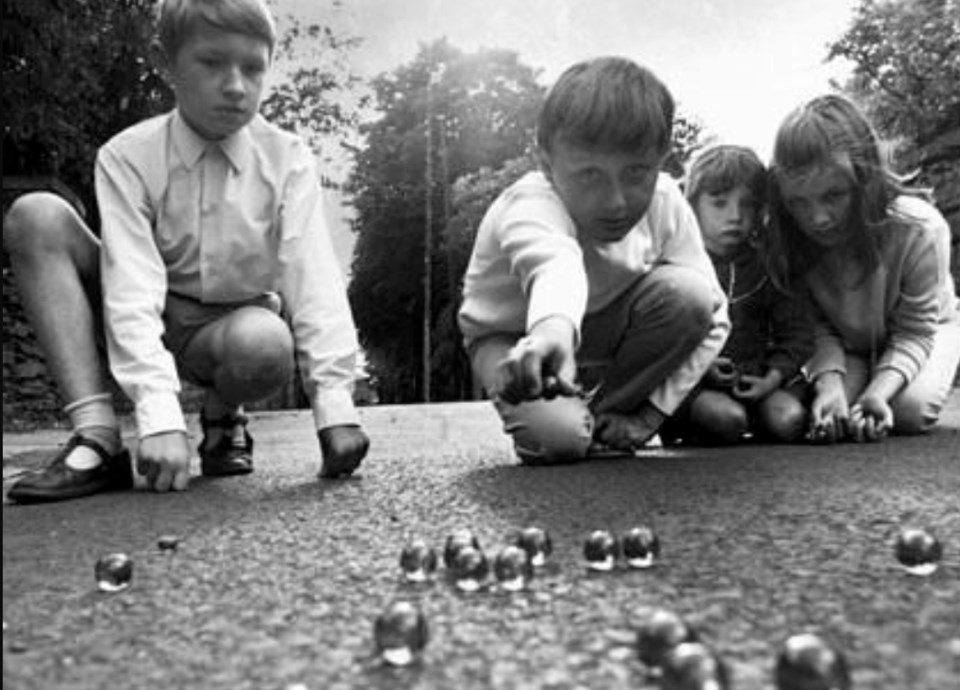“NO MARBLES, OUTLOOK DARK” said a headline in the Guelph Mercury one day in February of 1945. “Glass marbles are the latest commodity to fall under the wartime axe, according to local merchants,” the article said. “Young lads who ordinarily expressed their spring-inspired fancy with marbles may have to seek other forms of recreation.”
The public response to a difficult situation back then might be worth some reflection now.
The Second World War was into its sixth year, and like every other community in Canada, Guelph had to endure shortages. Domestic industries had been re-tooled to fill military needs. War is monumentally wasteful, and by the winter of 1944-45, much of the global production of farm and factory had been blown up, burnt up, or sent to the bottom of the ocean. Even in a country as bountiful as Canada, the seemingly relentless pressure on the supply chain made that of the present day a mere nuisance in comparison.
There was rationing of fuel and many kinds of foods. Clothes had to be patched up, handed down, and worn until they were worn right out, because new ones weren’t available. The same issue of the Mercury that reported on the marbles situation said children were going to school wearing their slippers in their overshoes because there were no new shoes in the stores due to shortages of leather and skilled labour. The wartime demand on materials of all sorts had also resulted in a housing shortage in Guelph.
Military need was the driving force behind the speedy development of new vaccines, and preventative medications that were lifesavers for soldiers did the same thing for civilians. But military need also put a strain on supplies of medications of all kinds.
That edition of the Mercury reported there had been a decrease in the number of people – mostly children – immunized against such contagious diseases as smallpox, whooping cough, diphtheria and scarlet fever. The numbers were down because of difficulties in getting the limited amount of vaccines to the people, not because anybody was refusing to have themselves or their children vaccinated, which most people of the time would have associated with a metaphor involving lost marbles.
For kids that year, boys especially, with spring on the horizon, the shortage of marbles had nothing to do with a figure of speech, but threatened an actual seasonal tradition that had been around for a long time, and would continue well into the childhood years of the baby boomer generation. Guelphites of that age, me included, will no doubt remember marble season at school.
It was probably pretty much identical to what the kids of 1945 knew.
You’d show up at school with a bagful of marbles, or a pocketful that clacked as you walked around. Every kid had an assortment: cat’s eyes, pearls, devil’s eyes, allies, oilies, crystals, swirlies, tiger’s eyes and steelies among them. There were larger marbles that we called aggies, but might have been known by other names in other times and places.
There were also mid-sized green ones that might have been unique to Guelph because they were supposedly made from excess fibreglass material in a local factory.
Kids would shoot marbles in the school yard at recess and on the sidewalk on the way home in the afternoon. (Not on the way to school because of the danger of being late and being sent to the principal’s office. Of course, there was always at least one smart alec who’d get in trouble for rolling marbles on the floor in class).
There were several different games, such as ringers and dropsies. The object in all of them was to win other kids’ marbles. You wanted to go home in the afternoon with more swag than you’d arrived at school with in the morning. I don’t recall anyone ever telling us that this was gambling, but if you had a losing streak, at the end of the week you’d wind up spending your allowance on a new bag of marbles so you could get back into the action on Monday.
However, in that spring of 1945, things would be different. For pre-teen and adolescent boys, it was almost like calling off the Stanley Cup finals. The Mercury reported:
“In all probability there are many of the coveted ‘smokies, wateries, dibs and glassies’ stored away in some secret places pending the break in weather. Likely some lad who has graduated from the ancient ‘Order of Alleys’ will have an accumulated stock to pass on to a younger member of the order. But any who are unfortunate enough to be caught without a supply on hand will be out of luck. Some local marble vendors were glad they wouldn’t be able to carry a stock of marbles this year, as it would save them from long discussions … couched in the profound terms and lingo of the marble shooting fraternity. It seems the language of the young connoisseurs is a far cry from everyday English. … On the other hand, some merchandisers expressed regrets that they would not be able to continue the happy business association with the lads.”
Within months the war would finally be over and eventually there would be no more need for tough measures. The health care system would have enough vaccines and other medications for everybody. Gasoline and heating fuel wouldn’t be rationed. Houses would be built. Store shelves would again be stocked with food, clothing, shoes, and – in time for the spring of 1946 – marbles.



